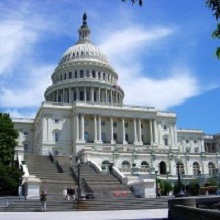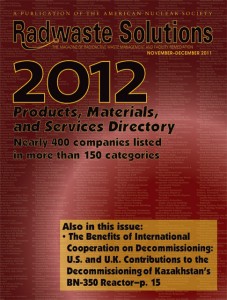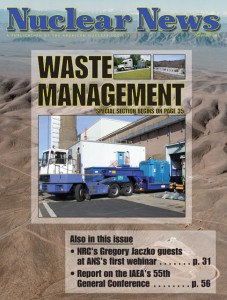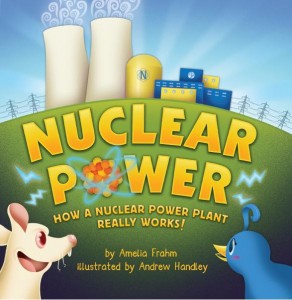81st Carnival of Nuclear Energy Bloggers
Fermi reactor concept - image courtesy of Will Davis at Atomic Power Review
The 81st edition is up at Idaho Samizdat.

A message from Electrical Builders, Ind.
America’s Top Performing Nuclear Plants Rely on Electrical Builders, Industries to Expand and Extend the Life of Their Critical Electrical Assets
Fermi reactor concept - image courtesy of Will Davis at Atomic Power Review
The 81st edition is up at Idaho Samizdat.
On December 2 in 1942, Enrico Fermi, Leo Szilard, and their colleagues achieved the first man-made, sustained, controlled nuclear chain reaction-in a squash court beneath the football grandstand of the University of Chicago's Stagg Field. That event occurred 69 years ago today!
Colocating all back-end facilities will increase community acceptance because of job creation
Shannon Bragg-Sitton of Idaho National Laboratory discusses nuclear applications for space missions, including the Mars Curiosity rover launched last Saturday, and the upcoming American Nuclear Society Nuclear and Emerging Technologies for Space (NETS) topical meeting, on March 21-23, in The Woodlands, Tex., held in conjunction with the March 19-23 Lunar and Planetary Sciences Conference. Please check the links above for more info.
 I'm sure everyone has heard all about the Solyndra "scandal" by now. There have been too many news stories to count on this subject (no need to provide links). So, instead of delving into the details, or giving a blow by blow account of all the events and the hearings in Congress, I will focus on the impacts this whole affair may have on government support for nuclear, and for clean energy in general.
I'm sure everyone has heard all about the Solyndra "scandal" by now. There have been too many news stories to count on this subject (no need to provide links). So, instead of delving into the details, or giving a blow by blow account of all the events and the hearings in Congress, I will focus on the impacts this whole affair may have on government support for nuclear, and for clean energy in general.
And wins a Nobel Prize
The 80th Carnival of Nuclear Energy Bloggers is up at Next Big Future
Many recent speeches (and blog posts) have compared nuclear and gas as sources of electricity generation for our future. In this post, I will bring the comparisons closer to home, describing some of the similarities and differences between the Vermont Yankee nuclear power plant in Vernon, Vt., and the Granite Ridge Combined Cycle power plant near Manchester, N.H. Which technology is the future: gas or nuclear? Or are they both the future?
During the American Nuclear Society's 2011 Winter Meeting in November, about 90 ANS members visited lawmakers to promote nuclear energy and technology as part of the ANS/Young Professionals Congress visit to Capitol Hill. As a student at Purdue University, which is located in Indiana, I met with legislative assistants from the offices of Indiana senators Richard Lugar (R.) and Dan Coats (R.) and Congressman Todd Rokita (R.).
 One of the most exciting and important events at the American Nuclear Society's Winter Meeting in Washington, DC, this year was the "Capitol Hill Day" visit held on November 4. This event allowed society members the opportunity to go to Capitol Hill to meet with congress persons and staffs, and to offer unique expertise as the world's foremost experts in nuclear technologies.
One of the most exciting and important events at the American Nuclear Society's Winter Meeting in Washington, DC, this year was the "Capitol Hill Day" visit held on November 4. This event allowed society members the opportunity to go to Capitol Hill to meet with congress persons and staffs, and to offer unique expertise as the world's foremost experts in nuclear technologies.
Voices with legendary names emerge each week to tell the story of nuclear energy
Projects in Koodankulam and Jaitapur will be set back
 The November/December issue of Radwaste Solutions is available in hard copy and electronically for American Nuclear Society members (must enter ANS user name and password in Member Center).
The November/December issue of Radwaste Solutions is available in hard copy and electronically for American Nuclear Society members (must enter ANS user name and password in Member Center).
 The November issue of Nuclear News magazine, which contains a special section on waste management, is available in hard copy and electronically for American Nuclear Society members (must enter ANS user name and password in Member Center). The special section contains the following stories:
The November issue of Nuclear News magazine, which contains a special section on waste management, is available in hard copy and electronically for American Nuclear Society members (must enter ANS user name and password in Member Center). The special section contains the following stories:
 NCEES is seeking engineering professionals to participate in a content review for the Fundamentals of Engineering (FE) exam. The results of this survey will be used to update the test specifications for the exam, which is typically the first step in the process leading to professional engineering licensure.
NCEES is seeking engineering professionals to participate in a content review for the Fundamentals of Engineering (FE) exam. The results of this survey will be used to update the test specifications for the exam, which is typically the first step in the process leading to professional engineering licensure.
 I originally wrote this post as a book review, but after three or four edits, I realized that I couldn't mask my biased opinion about the new children's book, Nuclear Power: How a Nuclear Power Plant Really Works! Simply put, I adore this book, as well as author Amelia Frahm, and have something of an emotional stake in its success. So, I decided it would be better to just share the reasons I love this book without trying to hide my enthusiasm.
I originally wrote this post as a book review, but after three or four edits, I realized that I couldn't mask my biased opinion about the new children's book, Nuclear Power: How a Nuclear Power Plant Really Works! Simply put, I adore this book, as well as author Amelia Frahm, and have something of an emotional stake in its success. So, I decided it would be better to just share the reasons I love this book without trying to hide my enthusiasm.
By Howard Shaffer
As part of ongoing efforts to keep the United States and U.S. communities safe during emergencies, the Federal Communications Commission and the Federal Emergency Management Agency (FEMA) will conduct the first nationwide test of the Emergency Alert System (EAS). The EAS test plays a key role in ensuring that the nation is prepared for all hazards, and that the U.S. public can receive critical and vital information should it ever be needed. The first nationwide test will be conducted Wednesday, November 9, at 2 p.m. eastern.